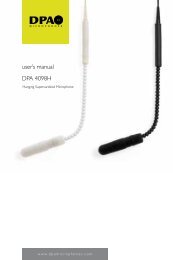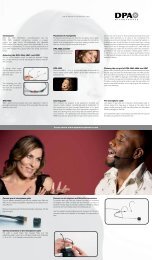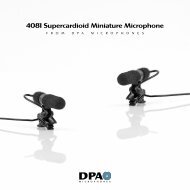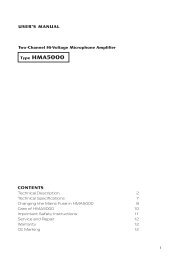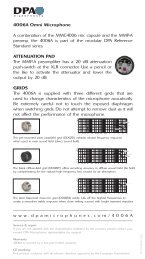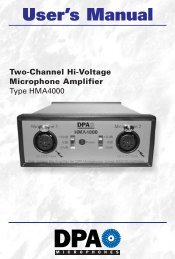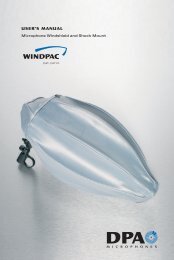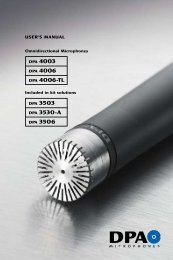4007 Manual.pdf - DPA Microphones
4007 Manual.pdf - DPA Microphones
4007 Manual.pdf - DPA Microphones
Create successful ePaper yourself
Turn your PDF publications into a flip-book with our unique Google optimized e-Paper software.
USER’S MANUAL<br />
Reference <strong>Microphones</strong><br />
Type 4004<br />
Type <strong>4007</strong><br />
CONTENTS<br />
Technical Description 2<br />
Full Specifications 7<br />
Care of Microphone 10<br />
Service and Repair 11<br />
Warranty 11<br />
CE Marking 11<br />
1
TECHNICAL DESCRIPTION<br />
The cartridge<br />
Omnidirectional (pressure) microphones <strong>DPA</strong> 4004 and <strong>4007</strong> use a<br />
12 mm (0.47 in) diameter prepolarised condenser cartridge. The<br />
diaphragm is a nickel foil which has been coated with an ultra-thin<br />
polymer layer for optimum corrosion resistance. The microphone<br />
housing is of German silver, an alloy with a high content of nickel to<br />
match the stable thermal qualities of the diaphragm. The self noise<br />
of the cartridge is typical 24 dB(A) re 20 μPa and the nominal sensitivity<br />
of 4004 and <strong>4007</strong> are 10 mV/Pa and 2.5 mV/Pa respectively.<br />
Due to the size of the cartridge it can handle extremely high SPLs,<br />
has an extended linear frequency response up to 40 kHz and a high<br />
degree of omnidirectionality, even for higher frequencies. For optimum<br />
stability the microphone cartridge has undergone a special<br />
pre-aging process which releases all tensions in the materials and<br />
stabilizes the polarisation voltage.<br />
The preamplifiers<br />
Types 4004 and <strong>4007</strong> are acoustically identical, but differ in their<br />
preamplifier powering system. The 4004 is powered with 130 V via<br />
the HMA5000 High-Voltage Microphone Amplifier and has a modified<br />
4-pin XLR-connector (see Fig. 1 for pin designation). This special<br />
powering system enables the microphone preamplifier to handle<br />
approximately 10 dB higher SPL than similar microphone types powered<br />
through conventional P48 systems (4004: 168 dB SPL peak<br />
and <strong>4007</strong>: 155 dB SPL peak).<br />
Furthermore, the 4004 together with the HMA5000 is a totally<br />
tranformerless system and therefore has an extended low-frequency<br />
handling capability (10 Hz to 40 kHz ± 2 dB). The <strong>4007</strong> is powered<br />
via a standard P48 system and is equipped with a high quality<br />
audio transformer and a standard 3-pin XLR-connector (see Fig.<br />
2 for pin designation). Types 4004 and <strong>4007</strong> use state of the art<br />
low-noise preamplifier technology and are driven with unity gain.<br />
All microphones come with an individual calibration chart with the<br />
specifications of self noise, sensitivity and the frequency response.<br />
Ground<br />
1<br />
2<br />
Signal<br />
Fig. 1. External view of the output connector of the <strong>DPA</strong> 4004.<br />
Fig. 2. External view of the output connector of the <strong>DPA</strong> <strong>4007</strong>.<br />
Important:<br />
The microphone will only operate within it's specifications if<br />
powered correctly.<br />
3<br />
4<br />
130 V DC<br />
Preamplifier Supply<br />
Ground 1 2 Signal +<br />
3<br />
Signal -<br />
2 3
The Passive Connection Converter<br />
The PCC4000 Passive Connection Converter is an optional accessory<br />
that makes it possible to run High-Voltage <strong>Microphones</strong> on standard<br />
48 V phantom power with reduced microphone specifications.<br />
The maximum reduction of the microphone SPL handling capability<br />
will be 13 dB and it is possible to drive up to 100 m (328.1 ft) of<br />
cable with the PCC4000 with the same specifications. Like the High-<br />
Voltage <strong>Microphones</strong> the PCC4000 is transformerless. The input<br />
connector is a modified 4-pin female XLR for connection directly to<br />
the microphone. The output is a standard 3-pin male XLR-connector<br />
for connection to standard cables.<br />
0° dB<br />
5 dB<br />
20 kHz<br />
15 kHz<br />
10 kHz<br />
5 kHz<br />
1 kHz<br />
Fig. 4. Directional characteristics of <strong>DPA</strong> 4004 and <strong>4007</strong> (normalised)<br />
40<br />
10<br />
dB<br />
5<br />
0<br />
On-axis<br />
dB<br />
30<br />
20<br />
ITU-R BS.468-4<br />
A-weighted<br />
-5<br />
5 dB<br />
Diffuse<br />
-10<br />
-15<br />
10 20 Hz 50 100 200 Hz 500 1 kHz 2 5 10 20 40<br />
10<br />
0<br />
-10<br />
200 Hz 2 kHz 20 kHz<br />
Fig. 3. On-axis and diffuse-field responses of <strong>DPA</strong> 4004 and <strong>4007</strong>. Fig. 5. Typical third-octave inherent-noise spectrum of <strong>DPA</strong> 4004<br />
and <strong>4007</strong>.<br />
4 5
Phase<br />
90º<br />
0º<br />
-90º<br />
Phase<br />
10 kHZ<br />
90º<br />
100 kHz<br />
0 10 20 30 40 50 60 70 80 90 100<br />
Fig. 6. On-axis phase response of <strong>DPA</strong> 4004 and<br />
<strong>4007</strong> plotted using a linear frequency axis for evaluation of the<br />
phase response.<br />
FULL SPECIFICATIONS:<br />
Cartridge type:<br />
12 mm (0.47 in) pre-polarised condenser<br />
Principle of operation:<br />
Pressure<br />
Power supply:<br />
4004: HMA5000 for 130 V or PCC4000 for P48<br />
<strong>4007</strong>: 48 V Phantom power<br />
Frequency range, ±2 dB:<br />
4004: On-axis: 10 Hz - 40 kHz<br />
<strong>4007</strong>: On-axis: 20 Hz - 40 kHz<br />
Phase compatibility:<br />
Max deviation between any two microphones: ±5° (50 Hz to 20 kHz)<br />
Directional characteristics:<br />
Omnidirectional<br />
Sensitivity nominal, ±2 dB:<br />
4004:10 mV/Pa; -40 dB re 1V/Pa<br />
<strong>4007</strong>: 2.5 mV/Pa; -52 dB re 1V/Pa<br />
Equivalent noise level A-weighted:<br />
Typ. 24 dB(A) re 20 μPa (max. 26 dB(A))<br />
Equivalent noise level ITU-R BS. 468-4<br />
Typ. 36 dB (max. 38 dB)<br />
S/N ratio, re. 1 kHz at 1 Pa (94 dB SPL)<br />
70 dB<br />
Max SPL, peak before clipping:<br />
4004: 168 dB<br />
<strong>4007</strong>: 155 dB<br />
Total Harmonic Distortion:<br />
Cable drive capability:<br />
4004: HMA 5000: Up to 300 m (984.3 ft)<br />
4004: With PCC4000: Up to 100 m (328.1 ft)<br />
<strong>4007</strong>: Up to 300 m (984.3 ft)<br />
Polarity:<br />
4004: Positive going sound pressure produces positive going<br />
voltage at pin 4.<br />
Pin 1: Ground, Pin 2: Not used, Pin 3: 130 V DC preamplifier supply,<br />
Pin 4: Signal. (See Fig. 1).<br />
<strong>4007</strong>: Positive going sound pressure produces positive<br />
going voltage at pin 2.<br />
Pin 1: Ground, Pin 2: Signal +, Pin 3: Signal return. (See Fig. 2)<br />
Difference frequency distortion:<br />
(DF2, DF3, Df = 80 Hz)
CARE OF MICROPHONE<br />
It is important to bear in mind the following points with regard to<br />
mounting, microphone care and the use of accessories:<br />
The microphone cartridge is tightly secured to the main body housing,<br />
and no attempt should be made to remove it. If a replacement<br />
cartridge is required, contact your local <strong>DPA</strong> <strong>Microphones</strong> representative.<br />
ENVIRONMENTAL POLICY<br />
This product is comprised by the Waste (WEEE) directive and<br />
should not be thrown in the garbage bin when obsolete. Instead,<br />
return it to your local <strong>DPA</strong> representative (or <strong>DPA</strong> <strong>Microphones</strong> A/S<br />
directly) who will dispose of the product in accordance with the current<br />
environmental standards.<br />
Use of windscreen is recommended when microphones are used in<br />
dirty or dusty environments.<br />
When not in use, the microphone should be disconnected and kept<br />
in the case supplied.<br />
SERVICE & REPAIR<br />
Products from <strong>DPA</strong> <strong>Microphones</strong> are extremely stable and there<br />
should not be any significant change in the specifications with time<br />
and use. If, however, you are not totally satisfied with the characteristics<br />
exhibited by these products, contact your nearest<br />
<strong>DPA</strong> <strong>Microphones</strong> representative for further details of service and<br />
the repair facilities that are available. <strong>DPA</strong> <strong>Microphones</strong> has a maximum<br />
seven working days in-house service policy, usually ensuring<br />
that no more than seven working days will elapse from the day we<br />
receive the item for service to the day we are ready to return it to you.<br />
Please contact <strong>DPA</strong> <strong>Microphones</strong> for your nearest representative on<br />
WARRANTY<br />
All products from <strong>DPA</strong> <strong>Microphones</strong> are covered by a two-year limited<br />
warranty on both mechanical functionality and documented specifications<br />
as long as the items are not mistreated, abused or modified<br />
in any way. In case of a warranty claim, your invoice is your warranty<br />
registration.<br />
CE-MARKING<br />
The CE-mark guarantees that the product conforms with relevant<br />
Directives approved by the European Commission.<br />
EMC Directive: 89/336/EC, amended by 92/31/EC and 93/68/EC<br />
Low voltage Directive: 73/23/EC, amended by 93/68/EC<br />
TEL: + 45 48 14 28 28<br />
FAX: + 45 48 14 27 00<br />
You can also get in touch with <strong>DPA</strong> <strong>Microphones</strong> at:<br />
info@dpamicrophones.com<br />
or visit our website at:<br />
www.dpamicrophones.com<br />
© 2005, <strong>DPA</strong> <strong>Microphones</strong> A/S - Product features and specifications<br />
are subject to change without notice.<br />
10<br />
11




